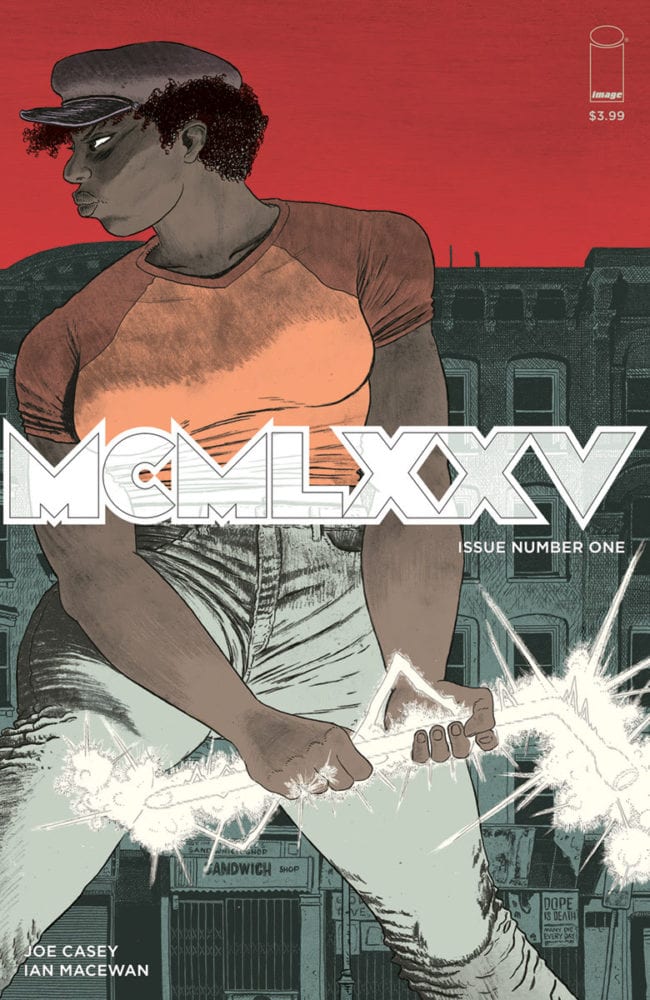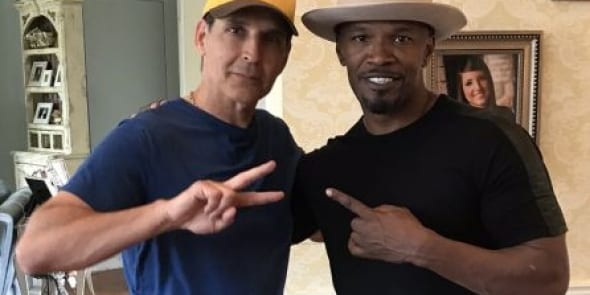Oh boy, another big day here. First, we have a previously unpublished roundtable conducted in 2012, all about the intersections between fine art and comics, as discussed by four artists with intimate understandings of both worlds: Marc Bell, Esther Pearl Watson, Joe Coleman, and Robert Williams.
DOOLEY: OK. Now let’s hear from Robert. [Chuckles.] I think you have one or two thoughts about what constitutes fine arts. So share them with us.
ROBERT WILLIAMS: Well, it’s kinda hard to follow Joe there, he’s a hard act to follow. Supposedly art is culturally the highest pinnacle of expression. And the word fine makes a big difference and that’s the big phony bone of contention. That word “fine” is supposed to imply sophistication. So sophisticated art. And this is a word that’s been around for a long, long time culturally and it’s a big selling point over a couple hundred years now. Just stick that word “fine” on it. It’s dribbled through our Western culture for a long time and you watch these revolutionary art movements come out of the late nineteenth century and then the period of the first world war. Then somehow they got to the top. The thing is, art is not just run by a few people. It’s run by schools and institutions and foundations and museums and art dealers. And the artists play a small part in that art thing and it’s unfortunate. You see artists get really famous and you wonder, “Well how’d that guy get so famous? That thing looks kinda goofy to me.” And it’s just that he was selected by this group, that this is gonna be what they were gonna push. Every new revolutionary form of art tries to violate that established situation. You can see that. You look at Van Gogh and you understand that if Van Gogh was born in the 20th century, he would have been an underground cartoonist. There’s no question about that. You look at that stuff and it’s calligraphy-dependent, it’s dependent on the drawn line. I know underground cartoonists that were comparable to that. So the question of “fine,” you know everyone wants to just tack that on them. People building model airplanes wanna tack that on. The thing is when nouveau riche people come into the buying market, dealers jump on these ignorant people and guide them. So they guide them to what’s pretty much easily established. So since the end of World War II, abstract expressionism kind of took over. Europe was really down on its luck and New York became the world’s art capital. It was a couple of New York art critics that pushed Jackson Pollock and he was in Life magazine and just busted this thing wide open. So nonobjective art just completely took over. And for nonobjective art to really get a good handle, these two art critics Clement Greenberg and Harold Rosenberg, instigators in this, kind of inferred that, if you visually depended, mentally depended on three-dimensional representation, you were kind of ignorant and you just didn’t have the sensitivity to appreciate two-dimensional and nonobjective art.
So that’s been kind of the mantra here in the last 50 years. It’s gone from abstract expressionism into pop art and to conceptualism. And you think, “Well wait a minute. You said pop art. That’s realistic stuff.” Well yeah, but it’s total appropriation. That’s like going to the 99¢ store and going up to the first shelf and grabbing something off the shelf and taking it over to one of these places that makes art for artists and say, “Can you make this about 20 feet tall for me?”
Over the coming days and weeks, we'll be following up with individual interviews that Michael Dooley conducted with each artist.
Greg Hunter is also here today, with a review of Michael DeForge's latest collection, A Western World.
The stories that populate A Western World, a collection of Michael DeForge’s recent short comics, make for troubled residents, concerned with the mutability of bodies, the relationship between body and self, and how technology affects intimacy—some of the same notions found throughout DeForge’s larger body of work. Readers fond of DeForge but new to these pieces won’t find major departures in the book, but that’s only one measure of the collection and perhaps not the best one. DeForge has long since found his themes and a sensibility with which to approach them. The pleasure of A Western World is the pleasure of seeing him return to these concerns from new angles.
The collection is a book of gradients, of pieces about bodies and societies rendered with different hues, in different keys, through different lenses. Within a sort of prevailing aesthetic (flat colors, limited hatching, figures and backdrops made of a few defining shapes), DeForge adopts a range of styles throughout the collection and manages to adjust his approach from story to story while remaining recognizably himself. For converts, the appeal here may be in the details, the minor changes, in addition to what concerns of theirs they find reflected. For newer readers, the book makes a fine introduction to a cartoonist who expertly blends form and subject.
Meanwhile, elsewhere:
—News. DC continues to make changes, following Diane Nelson's resignation with news that "chief creative officer" Geoff Johns will be leaving that position to take on a new role as "writer/producer." DC publisher Jim Lee will take over as chief creative officer.
The moves come in the wake of last week’s exit of Diane Nelson, DC Entertainment’s president, to whom Johns reported, and occurs the day before a judge’s decision will be announced in the high-profile antitrust trial between the U.S. Department of Justice and AT&T, which is seeking to merge with Time Warner, the parent company of both Warner Bros. and DC.
It also takes place as Warners’ movie division is in the midst of a transition as Walter Hamada, who was installed as president of DC-based films at the studio by Warner Bros. Pictures Group chairman Toby Emmerich in January, begins to shape the superhero slate in the post-Justice League era.
Yesterday, of course, we learned that the judge in question has approved the merger between AT&T and Time Warner, another huge step in the concentration of corporate among a very small number of media and communications companies.
Pittsburgh editorial cartoonist Rob Rogers has had nearly a dozen finished cartoons spiked this year.
So just what is going on? Why are so many of Rogers’s cartoons suddenly being spiked?
“I can only speculate,” the left-leaning cartoonist says. “While most of the killed cartoons or ideas were [directly] critical of President Trump, there were also some dealing with the NFL kneeling policy, issues of racism and the FBI.” More broadly, most of the spiked cartoons satirized issues on which Trump has taken a stance or that reflect the larger partisan divide in the Trump era.
Meanwhile, John Robinson Block, the Post-Gazette’s publisher and editor in chief, tells The Washington Post in a statement: “This is an internal, personnel matter we are working hard to resolve. It has little to do with politics, ideology or Donald Trump. It has mostly to do with working together and the editing process.”
The New York Times has published its obituary of longtime Mad editor Nick Meglin.
As Mad’s editor from 1985 to 2004 — a position he shared with John Ficarra — Mr. Meglin became a major figure in the magazine’s long history, along with Harvey Kurtzman, who founded it as a comic book; William M. Gaines, its Falstaffian publisher; and Al Feldstein, who ran Mad from 1956 to 1985.
“Feldstein was a smart editor, but he was a hard taskmaster,” Al Jaffee, the cartoonist who, at 97, still devises Mad’s back-page fold-ins, said in a telephone interview. “Nick, on the other hand, was simpatico to the contributors, which made us all want to be better.”
—Interviews. The Gothamist talks to Julia Wertz.
I quit drinking in my late 20’s, and got really interested in urban exploring. (Exploring abandoned places.) I guess I replaced my obsession with drinking with an obsession with history and buildings. I quit doing comics for two years, and focused all my energy on exploration, photography and research. 90% of the work I did during those years didn’t appear in my NYC book, but it did pave the way to getting into making art about history.
Then I met Roz Chast. I’d been a fan of hers for forever. It turned out she was a fan of mine as well, so we ended up becoming friends, and she got me a meeting with Bob Mankoff at the New Yorker. Bob wanted me to do gag cartoons, gags are not my forte, so I pitched him comics about NYC history, and those ran online for about a year before I got a book contract. Then I got evicted, moved back to California, finished the book, and got back into making autobiographical comics. I still love the city, and I love history, but I burned out making comics about it all. I was doing 16 hour days, seven days a week, drawing elaborate architectural stuff. I think maybe I went insane but I didn’t really know it.
































